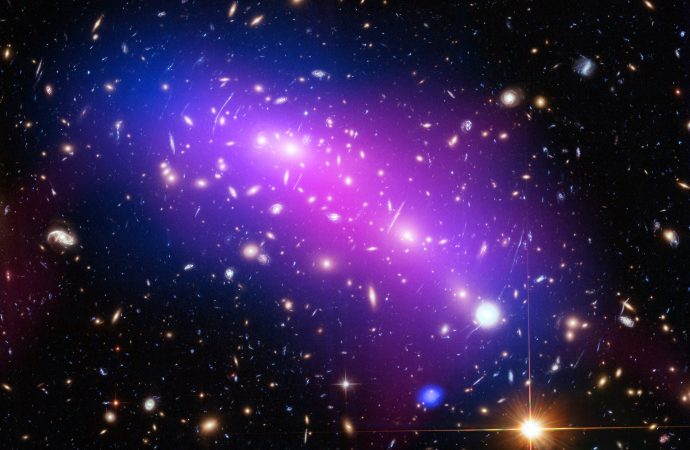The problem of Dark Matter
Understanding the building blocks of the Universe has been a preoccupation of physicists since the 1930s. Over the past 50 years, a major focus of this research has been investigating the nature of missing mass both within our own galaxy and beyond. Missing mass, or Dark Matter, is a catch-all term used to describe the processes which physicists cannot understand or unify without postulating the existence of an unknown particle. This particle must be extremely abundant, making up nearly 85% of the total matter in the Universe whilst interacting very weakly with the world around us.
Why do we need extra mass in the Universe? To trace the amount of mass in the Universe, we observe stars and other light-emitting materials such as hydrogen gas clouds. Galaxies like the Milky Way have most of their visible mass concentrated towards their central regions. We therefore expect the orbits of stars around the galactic centre (GC) to follow the normal Newtonian laws of gravity. To apply these laws we assume that the distribution of mass we see is the true mass distribution. For our solar system this holds true with the circular speeds of planets decreasing with distance from the Sun, the most massive object by far. Galaxies, on the other hand, do not exhibit this behaviour, instead we find that the velocities of stars far from the GC are the same as those that are close. One of the simplest explanations of this observational fact is the existence of an extended haze of DM enveloping the galaxy. Although galaxies are enormous compared to the Earth, they are considered the close to smallest scale evidence for dark matter.
At the largest scales, we have the cosmic microwave background (CMB). From the finite speed at which light can travel, objects with increasing distance appear further in the past. The CMB is the furthest back we can look, appearing with almost the same wavelength across the entire sky. This uniformity is broken by tiny fluctuations in the photon wavelengths which we interpret as the very first over- and under- densities shown, in the figure below, as blue and red spots respectively. Today the over-densities contain galaxies, stars, planets, and us, whilst the under-densities have become vast voids of emptiness. Possibly the most convincing evidence for dark matter comes from CMB photons. We can statistically predict these fluctuations with extreme precision but only when we allow for an additional particle which does not interact with the known normal matter.
Image Credit: ESA and the Planck Collaboration
By themselves, galaxies do not provide the extraordinary evidence required for physicists believe in dark matter. It is the concordance of a variety of observations that make the conclusion that an additional particle must exist and be extremely abundant, nearly inescapable.
Finding it on Earth
Although dark matter is constantly passing through our bodies and the Earth, we do not perceive it day to day. One possibility is that it interacts weakly with the other particles that make up the Earth; mostly protons, neutrons, and electrons. Over the last 10 years, physicists have been building extraordinarily sensitive detectors to look for these interactions. When particles interact, they transfer kinetic energy, just like balls in a snooker game. In these detectors, we can see the movement of the initially static particles but not what caused them to move. The goal is therefore to try to remove all other possible sources of collisions to maximise the chance that we will see something from dark matter. The difficulty comes from trying to increase the size of the experiment to the point at which a dark matter interaction is likely while keeping conditions stable enough to reject all other sources.
Ancient Minerals
Digging deep into the ground, it is possible to find rocks as old as one billion years. Researchers at Stockholm University recently proposed the use of these rocks as dark matter detectors, coining the term paleo-detectors. Unlike normal detectors, paleo-detectors have been exposed to an onslaught of dark matter particles for their entire life. This barrage of particle collisions could leave observable deformations in the otherwise crystalline structure of the mineral. At the University of Amsterdam, we analysed the possibility of pulling out this signal from all the backgrounds that might be present. In particular, we expect neutrinos, another elementary particle, to produce an observation much like dark matter.
Luckily the neutrinos have a tiny mass, allowing us to see the difference in the defects they would leave. Going back to the snooker ball analogy, most neutrinos would only be able to transfer a tiny amount of energy to a nucleus in the rock, akin to replacing the white ball with a ping-pong ball and trying to move one of the heavy snooker balls with it. Our analysis shows that looking for these defects in the rock could prove to be the most sensitive way to look for dark matter to date.
The Impossibility of the Experiment
The experiment will not be easy, requiring extensive calibration to understand how these defects in the rock form whilst deploying state-of-the-art nanoscale imaging devices in underground laboratories (must be underground to shield for cosmic radiation). The benefit of paleo-detectors may come from the various types of usable materials. Typical detectors require years of dedicated research to form stable enough conditions for a new material to be sensitive enough to find dark matter. Paleo-detectors, on the other hand, come with a variety of chemical compositions allowing for simple but rigorous cross-checks of any tentative signals. Finding dark matter won’t be easy but solving one of the most pressing issues in modern physics never is.
Bibliography
– Edwards, Thomas DP, et al. “Digging for Dark Matter: Spectral Analysis and Discovery Potential of Paleo-Detectors.” arXiv preprint arXiv:1811.10549 (2018).
– Drukier, Andrzej K., et al. “Paleo-detectors: Searching for Dark Matter with Ancient Minerals.” arXiv preprint arXiv:1811.06844(2018).
– Baum, Sebastian, et al. “Searching for Dark Matter with Paleo-Detectors.” arXiv preprint arXiv:1806.05991 (2018).
Thomas Edwards is a PhD student at GRAPPA (Gravitation AstroParticle Physics Amsterdam). His work is focussed on detecting dark matter by any means necessary.
Find out more here.





